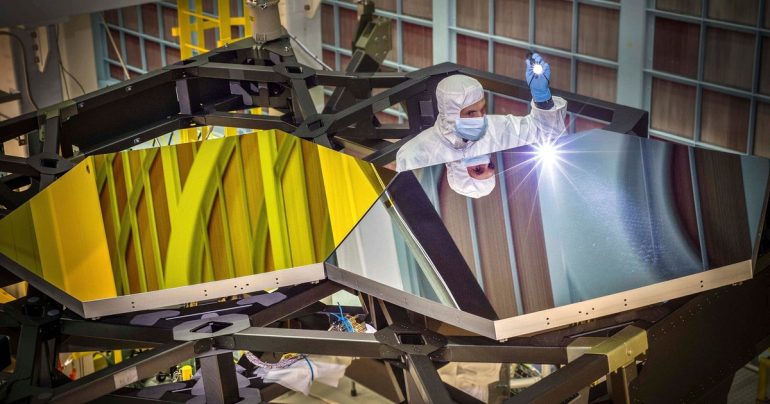Paris , Looking back billions of years into the universe – it should be possible with the new James Webb Space Telescope. After decades of development and several delays, the rocket with the precious cargo is now ready to launch from the spacecraft at Kourou in French Guiana on Christmas Eve.
The new telescope has surpassed its predecessor Hubble in size and complexity. Its mirror is 6.5 meters in diameter and needs to be folded to fit into the Ariane 5 rocket that will put the telescope in orbit. The James Webb Telescope will trace the early days of the universe to a few hundred million years after the Big Bang. The US space agency NASA states that it will “observe a never-before-seen part of space and time directly.”
Looking ahead in space means looking back and forward into the past. While light from the Sun takes eight minutes to reach our eyes on Earth, the new telescope will capture the light of the first galaxies that formed 13.4 billion years ago.
Astrophysicist: Webb may reveal “many, many more galaxies”
The Hubble satellite, which has been in use since 1990, primarily observes visible light. Webb, on the other hand, focuses on infrared radiation. Swiss astrophysicist Pascal Osch says the telescope will provide even more accurate images with a sensitivity 100 times higher. He is certain that “many, many more galaxies will appear, but they are far less bright”.
Webb will help explain an important stage in the evolution of the universe, when “light came when the very first stars began to form,” Osh explains. Ultimately, it’s also about finding out whether Earth is unique or whether there are similar planets on which life could arise.
Named after a former director of the US space agency, the new telescope was jointly developed by NASA, the European Space Agency (ESA) and the Canadian Space Agency (CSA). The Max Planck Institute for Astronomy, the University of Cologne and several German companies also participated.
Telescope glass and sun shield as big as a tennis court
The project, which began in 1989, was originally scheduled to go into operation in the early 2000s. Sometimes new problems delayed the project, with the cost tripling to nearly $10 billion (Euro 8.8 billion). “There is great excitement, we have been waiting for this moment for a long time,” says Pierre Ferruit, a scientist at ESA who has devoted most of his career to this project. Researchers are already competing for access to the new telescope that will orbit our Sun.
“The demands of observation time are enormous. For the first year of operation alone, ESA received over a thousand applications,” Ferruit says. “Even 20 years later, the questions the Web was built to answer They are just as important.”
But it will take some time for the telescope to deliver the first images: in about a month it should reach its orbit at a distance of 1.5 million kilometers from Earth. Then a mirror the size of a tennis court and a sun protection shield should come to the fore. Only when this challenge has been mastered and the mirrors adjusted properly can a look into the past of the universe begin in about half a year.


Internet fan. Alcohol expert. Beer ninja. Organizer. Certified tv specialist. Explorer. Social media nerd.





